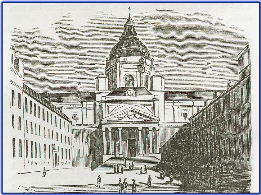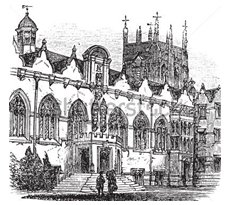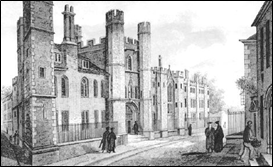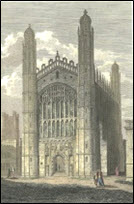


THE UNIVERSITY OF PARIS 1155 (H2)
Including:
Oxford University and
Cambridge University

xxxxxAs we have
seen, the first university was founded at Bologna in 1119 (H1). It was followed by
the University of Paris in 1155 -
Acknowledgements
The Sorbonne: engraving of 1855
– Brown University Library, Providence, Rhode Island, USA. Oxford
University: 19th century engraving – Trousset
Encyclopedia 1886-
H2-
 xxxxxAs we have seen, the first university in the accepted
meaning of the term was founded at Bologna in the 1119
(H1), and it soon won a reputation for
its schools of canon and civil law. The University of Paris was
the first to be established in northern Europe. It was founded
around the year 1155, developing from
and out of the cathedral schools of
Notre Dame, where the standard of instruction was proving too low.
By the end of the century it was the most famous centre of
learning in northern Europe, with faculties in theology, canon
law, medicine and the arts. Its well-
xxxxxAs we have seen, the first university in the accepted
meaning of the term was founded at Bologna in the 1119
(H1), and it soon won a reputation for
its schools of canon and civil law. The University of Paris was
the first to be established in northern Europe. It was founded
around the year 1155, developing from
and out of the cathedral schools of
Notre Dame, where the standard of instruction was proving too low.
By the end of the century it was the most famous centre of
learning in northern Europe, with faculties in theology, canon
law, medicine and the arts. Its well-
xxxxxAmongst
many colleges built to house the students was the Sorbonne,
founded by the theologian Robert de
Sorbon (1201-
xxxxxOxford University was originally modelled on Bologna. Set up in the 12th century, it received a boost to its
development in 1167 when Paris, following a dispute, placed a ban on
English students. As in Paris at this time, lectures were held in
churches and halls, and even when colleges were established -
 xxxxxThe general organisation of Oxford
University owed much to that evolved
earlier at Bologna. In its turn, the University of Paris served as
a model for other centres of learning which were developing in
northern and central Europe in the twelfth century. One such
centre of learning was situated at Oxford.
Here the university was well established by the end of the twelfth
century, a boost to its development coming in 1167 when, following
a dispute, Paris University placed a ban on English students.
Their arrival at Oxford not only increased the body of students,
but also brought innovation based on the Paris model. A further
thrust in its advancement, notably in theology, came in the
thirteenth century when several religious orders, including
Franciscans and Dominicans, came to settle in the city.
xxxxxThe general organisation of Oxford
University owed much to that evolved
earlier at Bologna. In its turn, the University of Paris served as
a model for other centres of learning which were developing in
northern and central Europe in the twelfth century. One such
centre of learning was situated at Oxford.
Here the university was well established by the end of the twelfth
century, a boost to its development coming in 1167 when, following
a dispute, Paris University placed a ban on English students.
Their arrival at Oxford not only increased the body of students,
but also brought innovation based on the Paris model. A further
thrust in its advancement, notably in theology, came in the
thirteenth century when several religious orders, including
Franciscans and Dominicans, came to settle in the city.
xxxxxAs in Paris,
there were no permanent premises in the early stages of
development. Lectures were held in local churches or halls, and
when colleges were established -
xxxxxThree
important institutions at Oxford are the Bodleian
Library, with a capacity for five million volumes, the Sheldonian
Theatre and the Ashmolean Museum -
xxxxxIn 1209 a group of Oxford scholars, wishing to escape the riots between "town and gown", left and settled at Cambridge. The first college was founded in 1285, and, with the arrival of Erasmus in 1511, it became a centre for Renaissance learning and the troubled theology of the Reformation. Then the coming of Isaac Newton at the end of the 17th Century and, later, the establishment of the Cavendish Laboratory in 1871, gave impetus to scientific study and research. Among its important buildings are the magnificent Kings Chapel, begun in 1446, and the library of the diarist Samuel Pepys, housed in Magdalene College.
 xxxxxCambridge University is generally thought to
have owed its beginnings to Oxford. In 1209 a group of scholars at
Oxford, wishing to escape the riots which were then taking place
between the townspeople and the students (between "town and
gown"), left the city and came to settle in Cambridge. The centre
flourished. The first college -
xxxxxCambridge University is generally thought to
have owed its beginnings to Oxford. In 1209 a group of scholars at
Oxford, wishing to escape the riots which were then taking place
between the townspeople and the students (between "town and
gown"), left the city and came to settle in Cambridge. The centre
flourished. The first college -
 xxxxxKing’s College Chapel (illustrated), begun in 1446, ranks amongst the world's most
magnificent buildings, and the library of Samuel Pepys, the diarist, is housed in Magdalene College. An
attractive view of some of the colleges can be seen from "the
Backs", the stretch of grounds and gardens which are situated
alongside the River Cam.
xxxxxKing’s College Chapel (illustrated), begun in 1446, ranks amongst the world's most
magnificent buildings, and the library of Samuel Pepys, the diarist, is housed in Magdalene College. An
attractive view of some of the colleges can be seen from "the
Backs", the stretch of grounds and gardens which are situated
alongside the River Cam.
xxxxxIncidentally, when honours degrees were
introduced in the eighteenth century the examination came to be
known as the "tripos" because of the three-
xxxxxSoon after the founding of Cambridge, universities were established in many of the major cities of Europe, including Salamanca in 1218, Montpellier in 1220, and Padua in 1222. Among those founded in the following century were Rome, Florence, Prague, Vienna and Heidelberg. From the late eighteenth century, theology and the classics were gradually replaced by literature and modern languages, and the study of science in all its forms began to take an ever increasing part in the learning process. Then in the twentieth century new disciplines were introduced, such as psychology, economics and the social sciences.


